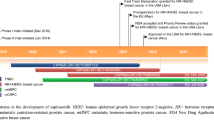Summary
VEGF signaling through VEGFR-2 is the major factor in glioblastoma angiogenesis. CT-322, a pegylated protein engineered from the 10th type III human fibronectin domain, binds the VEGFR-2 extracellular domain with high specificity and affinity to block VEGF-induced VEGFR-2 signaling. This study evaluated CT-322 in an open-label run-in/phase 2 setting to assess its efficacy and safety in recurrent glioblastoma. Eligible patients had 1st, 2nd or 3rd recurrence of glioblastoma with measurable tumor on MRI and no prior anti-angiogenic therapy. The initial CT-322 dose was 1 mg/kg IV weekly, with plans to escalate subsequent patients to 2 mg/kg weekly if tolerated; within each CT-322 dose cohort, patients were randomized to ±irinotecan IV semiweekly. The primary endpoint was 6-month progression-free survival (PFS-6). Sixty-three patients with a median age of 56 were treated, the majority at first recurrence. One-third experienced serious adverse events, of which four were at least possibly related to study treatment (two intracranial hemorrhages and two infusion reactions). Twenty-nine percent of subjects developed treatment-emergent hypertension. The PFS-6 rate in the CT-322 monotherapy groups was 18.6 and 0.0 % in the 1 and 2 mg/kg treatment groups, respectively; results from the 2 mg/kg group indicated that the null hypothesis that PFS-6 ≤12 % could not be rejected. The study was terminated prior to reaching the planned enrollment for all treatment groups because data from the completed CT-322 2 mg/kg monotherapy treatment arm revealed insufficient efficacy. Despite biological activity and a tolerable side effect profile, CT-322 failed to meet the prespecified threshold for efficacy in recurrent glioblastoma.


Similar content being viewed by others
References
Ostrom QT, Gittleman H, Farah P et al (2014) CBTRUS statistical report: primary brain and central nervous system tumors diagnosed in the United States in 2006–2010. Neuro Oncol 15(Suppl 2):ii1–ii56
Dolecek TA, Propp JM, Stroup NE, Kruchko C (2013) CBTRUS statistical report: primary brain and central nervous system tumors diagnosed in the United States in 2005–2009. Neuro Oncol 14(Suppl 5):v1–v49
Stupp R, Mason WP, van den Bent MJ et al (2005) Radiotherapy plus concomitant and adjuvant temozolomide for glioblastoma. N Engl J Med 352(10):987–996
Vredenburgh JJ, Desjardins A, Herndon JE 2nd et al (2007) Bevacizumab plus irinotecan in recurrent glioblastoma multiforme. J Clin Oncol 25(30):4722–4729
Friedman HS, Prados MD, Wen PY et al (2009) Bevacizumab alone and in combination with irinotecan in recurrent glioblastoma. J Clin Oncol 27(28):4733–4740
Kreisl TN, Kim L, Moore K et al (2009) Phase II trial of single-agent bevacizumab followed by bevacizumab plus irinotecan at tumor progression in recurrent glioblastoma. J Clin Oncol 27(5):740–745
Batchelor TT, Sorensen AG, di Tomaso E et al (2007) AZD2171, a pan-VEGF receptor tyrosine kinase inhibitor, normalizes tumor vasculature and alleviates edema in glioblastoma patients. Cancer Cell 11(1):83–95
Gomez-Manzano C, Holash J, Fueyo J et al (2008) VEGF Trap induces antiglioma effect at different stages of disease. Neuro Oncol 10(6):940–945
Tolcher AW, Sweeney CJ, Papadopoulos K et al (2011) Phase I and pharmacokinetic study of CT-322 (BMS-844203), a targeted Adnectin inhibitor of VEGFR-2 based on a domain of human fibronectin. Clin Cancer Res 17(2):363–371
Wong ET, Hess KR, Gleason MJ et al (1999) Outcomes and prognostic factors in recurrent glioma patients enrolled onto phase II clinical trials. J Clin Oncol 17(8):2572–2578
Weidle UH, Auer J, Brinkmann U, Georges G, Tiefenthaler G (2013) The emerging role of new protein scaffold-based agents for treatment of cancer. Cancer Genomics Proteomics 10(4):155–168
Mamluk R, Carvajal IM, Morse BA et al (2010) Anti-tumor effect of CT-322 as an adnectin inhibitor of vascular endothelial growth factor receptor-2. MAbs 2(2):199–208
Letarte N, Bressler LR, Villano JL (2013) Bevacizumab and central nervous system (CNS) hemorrhage. Cancer Chemother Pharmacol 71(6):1561–1565
Armstrong TS, Wen PY, Gilbert MR, Schiff D (2012) Management of treatment-associated toxicites of anti-angiogenic therapy in patients with brain tumors. Neuro Oncol 14(10):1203–1214
Wen PY, Macdonald DR, Reardon DA et al (2010) Updated response assessment criteria for high-grade gliomas: response assessment in neuro-oncology working group. J Clin Oncol 28(11):1963–1972
Schiff D, Reardon DA, Kesari S et al (2010) Phase II study of CT-322, a targeted biologic inhibitor of VEGFR-2 based on a domain of human fibronectin, in recurrent glioblastoma (rGBM). J Clin Oncol 28(No 15 suppl):2011
Batchelor TT, Mulholland P, Neyns B et al (2013) Phase III randomized trial comparing the efficacy of cediranib as monotherapy, and in combination with lomustine, versus lomustine alone in patients with recurrent glioblastoma. J Clin Oncol 31(26):3212–3218
de Groot JF, Prados M, Urquart T et al (2009) A phase II study of XL184 in patients (pts) with progressive glioblastoma multiforme (GBM) in first or second relapse. J Clin Oncol 27(15s): Abstract 2047
Paschold EH, Mazieres J, Lena H et al (2012) A randomized, double-blinded, phase II study of paclitaxel/carboplatin (PC) plus CT-322 versus PC plus bevacizumab (Bev) as first-line treatment for advanced nonsquamous non-small cell lung cancer (NSCLC). J Clin Oncol 30(No 15_suppl (May 20 Supplement)): Abstract 7584
Author information
Authors and Affiliations
Corresponding author
Rights and permissions
About this article
Cite this article
Schiff, D., Kesari, S., de Groot, J. et al. Phase 2 study of CT-322, a targeted biologic inhibitor of VEGFR-2 based on a domain of human fibronectin, in recurrent glioblastoma. Invest New Drugs 33, 247–253 (2015). https://doi.org/10.1007/s10637-014-0186-2
Received:
Accepted:
Published:
Issue Date:
DOI: https://doi.org/10.1007/s10637-014-0186-2




